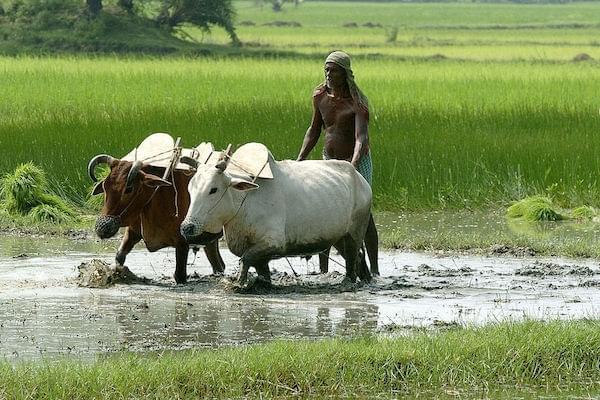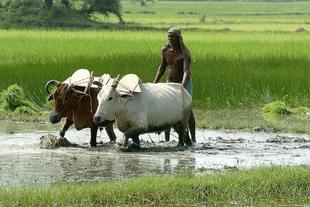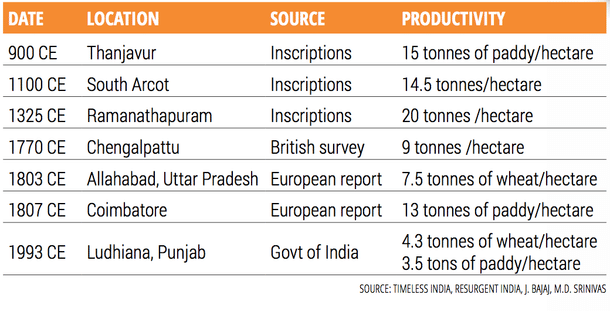Magazine
We Invented Farming
Rajeev Srinivasan
Oct 04, 2016, 05:02 PM | Updated 05:02 PM IST
Save & read from anywhere!
Bookmark stories for easy access on any device or the Swarajya app.


In the June issue of Swarajya, I suggested that India’s historical core competences were in agriculture, small-scale industry and innovation. Here I’d like to consider why agriculture, which may well have been invented in India in the first place, needs great focus, for there is nothing— literally nothing— more strategically important than food (and water) security. As an instance, during the Great Famines of the 1880s, entire districts on the Deccan Plateau were depopulated: Bellary by 20 percent, Kurnool by 25 percent, and Cuddapah by 17 percent: in summary, many millions of people perished. Have a look at this table below:

In the Economist Intelligence Unit food security index, 2016, India ranks a lowly 75th out of 113 nations. And survival is not enough. As the Indian population increases, and people become more prosperous, they will consume more and better food, including meat. This means the demand for agricultural output will increase exponentially, as it takes an enormous amount of grain and water to produce meat. Business as usual simply will not do. Indian yields are, unfortunately, declining.
Historical data, mostly from Tamil Nadu for paddy, compares well with the current, post-Green Revolution crop yields from Punjab, usually the highest in India. Overall current Indian yields are much lower than typical yields in the West or even China.

A few years ago, while doing research for a paper on food security, I found out that Mehrgarh in Baluchistan (at the foot of the Bolan Pass) is the first place in the Indian subcontinent where rice was cultivated: an astonishing 9000 BP (years before the present), or 7000 BCE. That is a remarkably long time ago, yet it makes sense, because the luminous urban Indus-Sarasvati civilisation of a little later would only have been possible with an agricultural surplus.
Similarly, of the two major species of cattle, one, Bos taurus indicus, was domesticated in India. A number of other breakthroughs in agriculture undoubtedly occurred in India, although, as usual, Western scientists tend to underplay the efforts of Indian farmers, ascribing their innovations to the “Near East” or China. But there is no denying that Indian farmers had access to a profusion of plant and animal varieties, both through natural selection and through selective breeding.
In the recent past, alas, India has blindly followed Western policies of monoculture, which can (and has) led to catastrophic crop failure: for instance, the U.S. Dust Bowl in the 1920s, and the potato blight in Ireland in the 19th century. The genetic variation endemic to India is threatened (and there are risks with artificially induced genetic variation). The germplasm of Indian crop variants, however, was allegedly smuggled out by Western researchers, and preserved in their seed banks. This could well be one of the greatest thefts of Intellectual Property Rights of all time.
For example, with climate change, robust, heat-resistant, salt-resistant local strains of food crops may well be better for Indian conditions than imported variants. Indeed, the IR-8-type rice strains of the Green Revolution have now caused soil and water exhaustion and soil poisoning with pesticide and fertiliser over-use in the plains of Punjab. Similarly, imported European cattle or fowl strains, bred for cooler climates, do not do too well in India’s heat.
As if this wasn’t enough, India has also been afflicted by the application of ill-considered economic theories. In Kerala, with some of the most fertile and well-watered paddy land on the planet, lakhs of hectares now lie fallow, or are being paved over and built on, forever lost. The unintended consequence of leftist ideas of an agricultural minimum wage has meant that it is not viable to cultivate rice. From being a rice exporter at the time of Independence, Kerala now imports 86 percent of its staple, rice.
There is a crying need for us to preserve and, where lost, rediscover traditional methods, and enhance them with technology. The country is blessed with good land: as much as 57 percent of the land is arable if irrigated, as compared to just 14 percent of their landmass for both the U.S. and China plus Tibet. It has a wide variety of climatic and soil conditions as well, ranging from Himalayan to plains to the semi-arid Deccan to tropical rainforest. Even though water stress is beginning to affect yields, on average, there is enough water from the monsoons and the glacier-fed rivers to sustain greater production.
There are new ideas being applied to innovation in agriculture, and they fall especially into two areas: one, the application of computing and electronic technology for more efficient food production, and two, the application of genetic engineering techniques to make existing crops better. There is an excellent summary of this in a recent issue of The Economist, and I shall borrow from their analysis.
The historical precedents for agricultural innovation in India are encouraging. British imperialists were astonished at the management practices they encountered in India, which were superior to their own. In fact, Prasannan Parthasarathi, as quoted by Mike Davis, argues that the average farm labourer in South India was better off than the average farm labourer in Britain in the 1700 CE timeframe.
Reports maintained in the British Library archives, obtained by the historian Dharampal, suggests that the British marveled at agricultural innovations in India such as:
• Crop rotation, manuring, sowing via the drill plough
• Propagation (eg. of rice) using cuttings
• Transplantation
• Irrigation.
Today’s technologies are of course different. In an era of diminishing water resources, it has become customary in India to overstress ground water, because of wrong-headed pricing of both water (zero) and electricity (zero) to pump it out for farming. Since the farmer has no idea when electricity will come on, he leaves the pump on all night, wasting both electricity and water.
One of the simplest technological solutions for this would be Internet-of-Things devices that can monitor soil moisture content and activate a pump (of course, that assumes there is electricity). More elaborate systems being used in the drought-prone almond farms of California’s Central Valley and connected wirelessly to the Internet can send a precise pulse of water, with fertiliser if need be, to the almond trees, down a drip irrigation system.
Monitoring the ground both with an army of such IoT devices, as well as satellite mapping, can provide increased benefits. In Kerala, there was an attempt a few years ago to collect soil information on a gross scale (at the level of a field, say) and document it. I am not sure how successful this was, but today, a combination of sensors can do a better job. Besides, using GPS satellites can give accuracy down to a few centimeters for any agricultural machine on the ground such as a tractor or a harvester.
As sensors proliferate, so does the Big Data available, which can be used over the years to accurately identify crop patterns, including information about weather, water flows, soil characteristics, and many other parameters so that you can increasingly precisely figure out what to farm where, and forecast the kinds of yields you get.
Better sensors such as multispectral cameras can be mounted on increasingly less expensive drones to do custom spraying of pesticides and/or fertiliser. It is also possible to optimize the spraying of liquid manure by accounting for variations in its composition. And all these devices can be controlled by comprehensive farm management software. Different types of agricultural robots are also being developed to meet specific needs. Some of these technologies may be well beyond the pale in India given the cost. However, simpler solutions may also dramatically increase agricultural output. The biggest problems in India are infrastructural: it is said that fully half the produce rots or is eaten by vermin. Thus, a major technological boost would be in setting up grain silos and other storage facilities as well as refrigerated trucks to transport sensitive goods.
The other technology that can come in handy for farmers is something that the government is already working on: a mechanism for price discovery. Fishermen in Kerala found that by using cellphones, they could disintermediate by selling directly to wholesalers. When out at sea, they could also decide on which fishing port to go to where they would get the best prices. According to a study, this resulted in a 12 percent improvement in efficiency; the fishermen pocketed eight percent, and the consumer kept four percent.
Thus,a mixture of low-technology and high-technology innovation can help improve the lot of farmers; once they earn better returns, they will be encouraged to invest more, and that becomes a virtuous cycle, so that India can once again become the agricultural-surplus nation it was in centuries past, and famines are nightmares that never haunt us again.
Rajeev Srinivasan focuses on strategy and innovation, which he worked on at Bell Labs and in Silicon Valley. He has taught innovation at several IIMs. An IIT Madras and Stanford Business School grad, he has also been a conservative columnist for twenty years.




